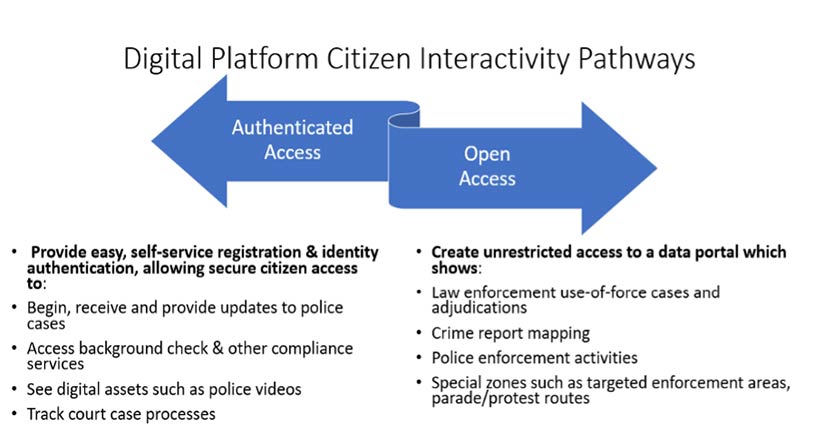Information Technology: Bringing Transparency to the U.S. Justice Reform Effort
December 7, 2021 / Patrick Doyle
Digital modernization can help improve police-public relations
It’s no secret the relationship between portions of the public and law enforcement has been strained in the United States—and in the news nearly as much as COVID-19. In fact, during the 2021 legislative sessions, more than 3,000 related bills were introduced in state legislatures, along with bipartisan negotiations in Congress concerning national policing issues. Review of the U.S. justice system has become a public policy priority in many areas of the country. But most of the changes being considered address operational and tactical elements of policing, which will take a long time to debate, with no certainty around enactment and implementation.
However, there is a way to achieve a measure of success in a shorter timeframe and with immediate impact: utilizing information technology to enhance visibility to justice data while increasing citizen digital interactivity with law enforcement.
Building trust through transparency
Currently, there is limited public access to justice information and even less citizen ability to interact digitally with law enforcement agencies. Citizens cannot readily see police use-of-force statistics or easily obtain information such as body camera videos taken during incidents. In a world where people expect instant access to information, the inability to tap into data and interact with police is perhaps inadvertently breeding mistrust. The free nations of the world all generally base their policing on the idea that “policing is allowed by consent of the public.” Improving and increasing visibility to police activities will go a long way toward improving the necessary and very active connection between the police and the community they serve.
Improving digital citizen interactivity with the justice system can help begin to ease some of the concerns being raised. Increasing the public’s visibility into police activities can occur quickly by utilizing technology to make information and police data more accessible. It can also vastly improve how citizens give and receive information from police.
Closing this information-sharing gap between police and citizens may help prevent misunderstandings before they begin. It can also gradually increase mutual respect between law enforcement and the community. Accountability and ease of access to police information will give citizens better insights into the challenges of law enforcement.
Here is an example of how modern technology can improve justice-to citizen information flow:

The above are suggested integration and visibility pathways that can be conducted through a partnership between justice agencies (police departments, attorney generals other public safety entities) and jurisdictional technology authorities or other executive-level government bodies. Both politically-elected officials and sworn-to-serve officers can use common technological platforms to increase confidence in law enforcement among disenfranchised portions of the population.
One Change, Many Benefits
Increasing information flow and visibility at the policing level within the justice continuum will have many positive impacts, including re-setting of the police-to-citizen rapport. But Justice Reform changes aren’t just about the police anymore. In reality, reform demands are becoming broader, reaching into other areas of U.S. local, state and federal government to include the courts, legislative bodies, prosecutorial agencies, education and more. Expectations are gradually increasing that all government agencies will deliver services in a more inclusive nature. The good news is “Digital Citizen Interactivity Pathways” can be used to provide better touchpoints and broader visibility to all government agencies and services, not just police departments.
Building or enhancing technology platforms to allow greater visibility and offering citizens a means of authenticating their own identity to gain secure access to more sensitive information can improve the public’s relationship with government. A more informed public will see a clearer picture of how things operate, including the justice system. It will also create better interactive experiences with the government, instead of leaving the public to form opinions based upon anecdotal events or biased media reports.
Justice Reform has the attention of U.S. policymakers and many residents. It is in everyone’s best interest to work together to improve the way government carries out enforcement and delivers justice. Increased visibility and secure interactivity are good places to start while the tactics and practices of policing are addressed over time.
Sir Robert Peel was a 19th-century British statesman who created the world’s first police force in London. He once wisely said, “The public are the police, and the police are the public.” The time is right for U.S. governments to use technology as an important step toward reconciling these two halves of ourselves.


